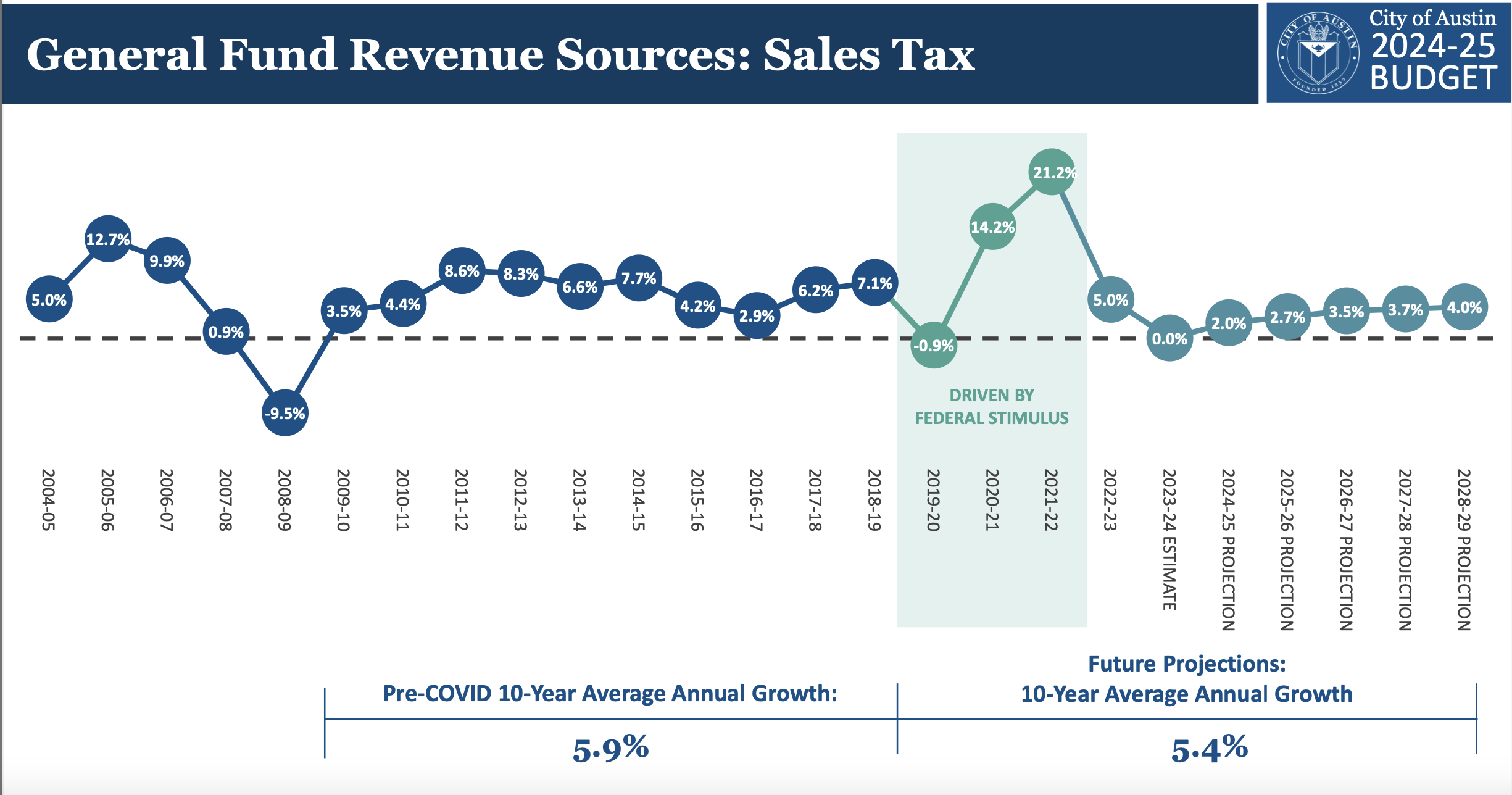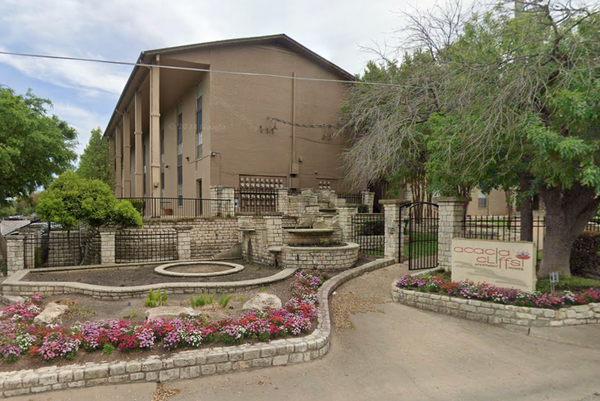A sobering budget update
The sales tax isn't saving us anymore.

I'm not typically a fan of cloudy skies, but learning about Central Texas's looming water crisis has heightened my appreciation for rain.
Sales tax problems
City budget staff yesterday offered a humbling forecast for the upcoming fiscal year. City Council will likely have less money to work with than expected when it takes up the FY 2024-25 budget in August due to lackluster sales tax revenue.
Over the past few years, the city has benefited from a post-pandemic retail boom, likely aided by unprecedented federal stimulus and inflation. The tremendous growth in sales tax revenue helped the city delay the hardship anticipated from the property tax limits put in place by the state five years ago. We knew that the tax limits were eventually going to catch up to us, but the sales tax gave us a few extra years of breathing room.

The city's budget analysts have consistently warned that the crazy sales tax growth was not going to continue, but the slowdown that has occurred in the past year has been even greater than they anticipated.
"We thought we were very conservative with [forecasting] a 3% sales tax growth," city budget officer Kerri Lang told Council members yesterday.
Alas, so far the growth rate is 1.4%.
So, Council needs to be careful with its spending. But just as important, the city needs to think strategically about how to increase revenue.
There are really only two ways to do that:
- a tax rate election where voters approve increasing taxes above the state limit
- new development
The latter point has rarely been publicly embraced, but it should absolutely be part of the conversation around land use. Regulations that inhibit dense development in the city hurt the city budget in two different ways.
First, a potential development that doesn't occur is a missed fiscal opportunity, since new development is exempted from the 3.5% property tax limit.
Second, dense development in the urban core is less costly to serve long-term. It stands in stark contrast to new sprawl development, which taxes city resources (roads, emergency services etc) much more.
While I can't speak to the wisdom of all of the infrastructure upgrades proposed for the South Central Waterfront, it makes sense that what seems like a big investment ($300M+) to dramatically expand downtown will pay huge dividends for the city long-term. If there are developers who want to build in that area, we should hope they build as big and tall as possible. Hopefully the court decision blocking the city's proposed infrastructure investment plan for that area does not lead to a huge forfeit in density. If it does, then the irony is that the self-professed taxpayer advocates who sued to block the plan may very well be laying the groundwork for future tax increases.
A strategy for revenue growth should be a key part of the election year discourse. Candidates for mayor and Council who want to talk about preserving or bolstering city services should be ready to tell us how they plan to grow the revenue to fund them.
A builder/preservationist alliance runs into city staff
A measure approved by City Council to encourage the preservation of old homes has been warped by city staff to the point of being useless, according to homebuilders.
The "preservation bonus" was included as part of Phase 1 of the HOME initiative that Council adopted in December. Its inclusion was a triumph of an unusual collaboration between builders and historic preservation advocates.
And yet, the measure that ultimately passed was already weakened due to resistance by city staff, say the builders. The bonus was originally envisioned to allow a fourth unit on lots if the original home was preserved, but staff stripped it out at the last minute, saying that they had forgotten to include it in the public notification.
Even without a fourth unit, there was hope the preservation bonus that did pass would still prove useful. Those hopes have since been dashed. To understand why, we need a quick rehash on Floor to Area Ratios (FAR), one of the city's most powerful housing regulations.
For a typical one-unit development, the FAR limit is 0.4, which means that the total floor space can be equal to 40% of the lot. So if you have an 8,000 sq ft lot, you cannot build more than 3,200 sq ft of house –– no matter how many stories.
Under HOME, the FAR limit for a two-unit project is 0.55 and for three units it's 0.65. So instead of building one 3,200 sq ft unit on that 8k sq ft lot, a builder could instead construct three 1,700 sq ft units (5,200 sq ft total).
As written, the preservation bonus says that if you maintained an old unit on the lot, it would not count towards the FAR limit.
Builders assumed that this meant that a lot with one old house and two new units would be treated like a three-unit development, but with the old house not counting towards the FAR limit. Therefore, the two new units would be allowed to go up to 0.65 FAR.
Staff, however, views that project as a two-unit development. And the two new units are limited to .55 FAR.
"There really in essence isn’t a FAR bonus anymore on most lots," says Ki Gray, a homebuilder and president of the Austin Infill Coalition.
There is not much economic incentive for the builder to keep the old house. Especially since in most cases the existing house is small. Unless you're going to get extra FAR for the two new units, the typical builder would prefer to demolish the existing unit and build three new ones.
The only reason one would opt to do so is if they happen to have a personal interest in preservation, as is the case for Gray.
Lindsey Derrington, executive director of Preservation Austin, says she was also "really caught off guard" by staff's interpretation.
"City Council supported this framework during HOME Phase 1, as did the Planning Commission," she said in an email. "We have to create an environment where preserving historic-aged houses makes sense whether you're passionate about historic buildings or just want to maximize your site's development potential."
Others argue that staff is being unfairly blamed f0r Council's rush to pass a half-baked ordinance. The point of HOME was to encourage smaller, more affordable units, they say. If Council wants to allow monstrous second and third units, they should specify that in a new ordinance.
A spokesperson for the Development Services Department said they are "aware that stakeholders have raised concerns about the FAR calculations, and we are taking steps to better understand their specific concerns about the implementation of the Preservation Bonus."
If somebody forwarded you this email, please consider subscribing to the newsletter by visiting the website.




